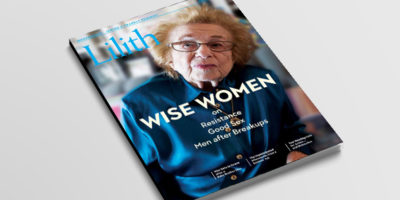Moses in Real Life?
The new book by Avivah Zornberg, Moses: A Human Life, though presented as a “biography” (it appears in Yale University Press’ series on “Jewish Lives,” the other volumes in which are, in fact, biographies), is not really a biography. Zornberg herself says that writing a “biography of Moses” is impossible, and recounts her own hesitation in writing a volume for the series. The sources on Moses in the Bible and midrash are, on the one hand, not evidence of the sort one uses in writing a modern “life.” And on the other hand, Moses, in the Jewish tradition simply “looms too large” for such a task; he has become too much to document in that way, especially in a tradition which values contradictory views rather than paring them away!
Despite her misgivings, Zornberg ultimately felt impelled to respond to a tendency in some quarters to see this looming Moses as “irreducibly Other,” so “special” that he nearly ceases to be an ordinary human being, and instead verges on perfection and infallibility. Addressing even those who might feel that “reducing” Moses to fit into an ordinary biography is a kind of impertinence, Zornberg proposes that Moses’s essential humanity is a crucial aspect of his message, one which cries out to be accounted for.
With her portrait, Zornberg appeals both to those who think primarily of Moses as a literary character (albeit a sacred one), and those with more literal understandings of Moses’s life. We are meant to understand that the key to Moses’s selection as God’s appointee is that his “specialness” is directly linked to his humanity, with all that entails (fear, disability, identity crises, vulnerability to trauma, acute disappointment and anger). This message would be gravely undermined by thinking of him as a perfect or completely other-worldly being. We, his People, are meant to identify with Moses as well as revere him; Moses stands in for all Israel, and what he struggles with so do we.
Zornberg tackles Moses’s relationship with language—a challenge throughout his life, given his self- avowed “speech impediment”; his sense of self, given his dual origin (Israelite family and Egyptian family); and his relationship to gender and gender roles. At one point Moses accuses God of casting him as a wet-nurse to the People Israel, and Zornberg explores the issues this raises about Moses’s sense of self, as well as what it might say about Moses’s relationship to the People. Likewise, she explores the ways in which Moses the Prophet acts as the “assertive wife” in relation to God, along with other feminine associations with him which already appear, largely untapped, in rabbinic sources. Moses’s presentation therefore blurs gender distinctions and rejects gender stereotypes. That, along with his modesty, illuminates how and why our embodiment of ideal leadership in Moses specifically rejects the macho, self-entitled model.
To appreciate what Zornberg’s “biography” of Moses succeeds in doing requires either setting aside as irrelevant our possible disbelief in Moses or our investment in some particular allegorical or “religious” version of him. Zornberg crafts a portrait of the biblical Moses using her uniquely evocative midrashic method. Her approach is founded upon both the contextual reading (the “peshat” of the text) and the midrash, stories about Moses which attempt to fill in the blanks left by the biblical text. She is also somewhat eclectic, bringing in insights from Jewish philosophy, Jewish fiction, and other works.
But what Zornberg’s method really does is meld an astute literary reading of the text with psychoanalytic insight. What results is immensely interesting and appealing, at times moving, even to a skeptic of the psychoanalytic worldview. This is likely because when she “evokes the inner world of Moses” she isn’t so much psychoanalyzing the man as she is doing a literary analysis of the textual tradition he inhabits, and what, in her view, that suggests about his and our relationship with God and other human beings. One example concerns the relationship between Moses and language. He is sent to redeem the Israelites from Egypt, and is the giver of Israel’s Law, making him a communicator of ultimate importance! Yet the text is charged with ambivalence about speaking and failures of communication. Zornberg’s analysis of Moses’s difficulties point to the ambivalent relationship we have with language itself—and therefore also with our sacred textual traditions.
Chana Thompson Shor is a Conservative rabbi, the first woman mesader gittin (preparer of Jewish religious divorce), a Judaic fabric artist, and a writer.



